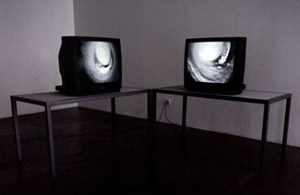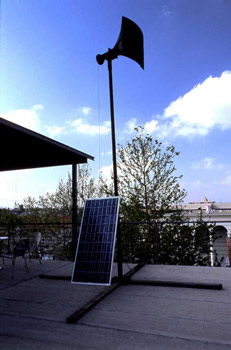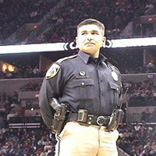I once heard a segment on the NPR radio program This American Life, in which a guy asked his friends which superpower they would want given two choices: invisibility, or the ability to fly. Apparently this is a very hard choice.

Paul Pfeiffer, Untitled, 2003 (Working title Guard) ... Monitor, armature, and video loop on DVD... 2 minutes
I listened to the interviewees waffle back and forth, weighing their options, and I found myself (like many other interested listeners I’m sure) thinking about the relative desirability of my options.
After some thought, I began to think that these seemingly polar opposite super-powers, the invisible and the hyper-visible, were not so different after all. Both in effect isolate the individual by shifting their perceived significance relative to the larger world. If you choose invisibility, you become the ultimate nobody; if you choose the ability to fly, you will inevitably become a star.
The works by Paul Pfeiffer currently being exhibited at ArtPace as a part of the first residency of 2003 utilize our shared vocabulary of pop stars, beauty queens and celebrity athletes to examine our perceived individual significance in relationship to each other, to the universe, and maybe even to God. The show consists of 4 pieces: three videos and one digital print, each occupying an entire wall of the darkened gallery. The four pieces, like most of Pfeiffer’s well-known work, are relatively small, and are lit solely by the projected images in the case of the videos, and by a single very bright spotlight in the case of the digital print. The dichotomy between observer and observed is emphasized by the darkness of the gallery, allowing the viewer to become the invisible and autonomous witness to the spectacles of Pfeiffer’s constructed universe. I found myself relieved to stand in front of the illuminated work, surrounded by darkness. It somehow reminded me of the sovereignty and in many cases control that anonymity provides.

Brian Fridge, Sequence 1.11, 2003... Two 4-minute, 30-second DVDs, two 36-inch monitors on two steel tables
This relationship between the visible and invisible seems to be especially apparent between the two projections entitled Caryatid, and Untitled, (working title Guard), which are positioned on opposite walls within the gallery. In Caryatid (the name refers to a carved figural column, usually associated with classical Greek architecture), Pfeiffer has carefully erased the image of the newly crowned Miss USA from what is probably her first press conference. Leaving only the cobalt blue background with its polka-dot pattern of ABC insignias, the flashes of photographers, and her small gold crown (which seems to tip back and forth like the movements of a marionette), Pfeifer creates something that is funny, but also critical, successfully distilling the event to its raw, thoroughly unromantic components.
In Untitled, (working title Guard), Pfeiffer presents us with the image of a solitary guard standing before a crowd on the basketball court. Unlike most of Pfeiffer’s video work, it is not immediately apparent how this longer looped piece of video documentation has been altered. The Guard shifts his weight, looks around, his expressions alternating between a certain wariness, and the subtle facial expressions that signal a sense of self-importance. But unlike Caryatid, this piece seems less like a critique on a transparent desire for recognition, and more like an act of empathetic appreciation. It is easy to relate to the predicament of this guard, who has been thrust by the artist into the limelight, and has unwittingly become the subject of our collective gaze. I think this piece is especially interesting for it’s compassion. In a way, the guard becomes a mirror, reflecting our own conflicting desires to be invisible and to fly, as a way to explain our broader societal infatuation with fame and celebrity.
In contrast to the intimacy and vulnerability of Pfeiffer’s projections, the work of Brian Fridge feels like it’s a million miles a way. The show consists of four video pieces on large television monitors that sit on sturdy, nondescript gray worktables. On first inspection, the black and white images seem to document the natural phenomena that are the most distant from us, the unfathomably huge and unimaginably small. The videos depict what seems to be the formation of galaxies and the multiplication of cells, pulsing and swirling accompanied by the sound of muffled wind coming from somewhere above our heads. This theme of creation is further emphasized by the blackness that marks the beginning and the end of each video. These pieces are not continuous loops, but events that appear and disappear quietly and magnificently like the witnessing of a solar eclipse.

Brian Fridge, Sequence 1.11, 2003... Two 4-minute, 30-second DVDs, two 36-inch monitors on two steel tables
One piece entitled Sequence 2.3 marks a departure from Fridge’s more familiar cosmological images that record the movements of ice crystals and steam. Sequence 2.3 documents the kaleidoscopic movement of bubbles in some kind of black liquid, which form and then are sucked away from the viewer into ambiguous blackness. The hypnotic rhythm of the cycle of creation and destruction is at once beautiful, and frightening. Like much of Fridges work, Sequence 2.3 seems to locate itself outside of the symbiotic viewer/ image relationship that much of video and film relies on. Fridge’s carefully observed and documented video sequences will take place whether anyone one is watching or not, and this realization has a way of making you feel very small.
There is a seriousness and rigor to Brian Fridge’s work that I find to be both inspiring and intimidating. Like my friend Eleanor, a classical cellist who spends literally hours each day practicing her bowing as well as other strange and meticulous techniques needed to be a great cellist, Fridge’s work seems to be based on a commitment to long hours of quiet observance and recording.
The piece entitled Sunset Song by Scottish artist Susan Philipsz is an altogether different kind of experience. Sunset Song, like much of Philipsz” work, involves publicizing a very private experience by broadcasting the singing of historical, popular, and familiar songs over public address systems. In Sunset Song, Philipsz recorded herself performing Banks of the Ohio, an American folk song about murder from both a male and female perspective, and installed the two tracks on opposite solar-powered speakers, creating a kind of call and response duet on the roof of the ArtPace building. The volume, guided by the intensity of the sun, ideally was supposed to fade away as night approaches. What I found interesting about this piece was how much it changed in light of where the viewer/listener was positioned.
My favorite experience with the piece was actually not anywhere near ArtPace, but closer to my studio a few blocks away. The voices that traversed the distance so easily were simultaneously very far away, and very close by. Like listening to the high school marching band that used to perform down the street when I was a kid, hearing Philipsz” disarmingly simple, straightforward voice singing this nostalgic American folk song through the bustle of downtown was beautiful and ghostly in its all pervasive presence.
![]()
I felt completely different about the piece standing on the roof of ArtPace, or watching the documented performance video in the gallery. Without the mediation of the mundane, I found the piece to be less effective, and almost a little uncomfortable. Kind of like listening to someone sing karaoke who is actually a pretty good singer.
In an article for the Summer 2000 issue of ArtForum Katy Siegal quotes Paul Pfeifer talking about basketball. In the article he says, “To see (Michael Jordan) soar through the air, a sparkling, shiny creature traveling at the speed of light, landing in every first, second, and third city all at once, is to understand you play a very minor role in a very big game….”
I think this kind of exploration of personal significance within larger societal end environmental contexts might be the one thing that connects the work of Paul Pfeiffer, Brian Fridge, and Susan Philipsz. All three artists present the quandary of flying vs. invisibility, the weighted question of our individual destiny in light of the possibility of a grander plan. I personally think this is a very worthwhile question to ask.
Images courtesy the artists and ArtPace.
Joey Fauerso is an artist who lives in San Antonio.



